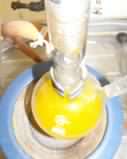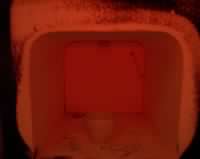Prepreg Analysis:-Standard suit of tests for prepreg prior to moulding
Resin Content: Usually using solvent wash to remove resin and leave the fibre
Fibre Content: remaining when resin removed
Flow: The ability of the resin system to move just before it Gels so that it is able to wet out the fibres and to bond between layers of a laminate. Good QC tool for ageing resin systems
Volatiles: Determination of the lower boiling point solvents
Resin Gel time: The time the resin takes to reach a gel point
Panel Fibre content ,fibre volume and void content
Using burn off:- This is used a lot with glass fibre /resin systems. The resin is burnt off and the fibre cooled and weighed. Standards such as ASTM D2584
and BS 2782 Pt10 M1002 loss by ignition.
Acid Digestion: Used a lot with carbon fibre systems. The resin is dissolved in boiling sulphuric acid and then oxidised. The remaining fibres are dried and weighed . Standards such as ASTM D3171
Adapted Digestion : used for kevlar fibre and thermoplastic fibre systems .
Density:-Using a variety of techniques Such as BS903-A1 (ISO 2781)
Thickness: paint/coatings based on ISO 2808 Method 6A Cross section
Colour: Using a range of spectrometers
Gloss: All three angles to BS EN ISO 2813
Melt flow rates : for a range of materials. Standards such as ASTM D1238 ,ISO 1133, BS2782 Pt7 method 720,BS EN ISO 1133
Wear testing: a variety of loads and substrates. Taber abrasion, Crockmeter abrasion tester AATC Test method 8. Colour Fastnessfor textiles,wet and dry rubbing, Scuffing, ISO 105,BS1006,BS EN 20105
Crockmeter( wear test)
Originall designed to simulate the actio of a human finger and forearm, the crockmeter uses a standard pressure and rubbing action to provide reliable and reproducible test results. Specimens ate positioned on the base of the crockmeter and held in place with a sample holder. A motorised crank moves areciprocating arm a distance of aapproximately 100mm. The rubbing action is provided by a 16mm diameter artifical finger which moves back and forth in a straight line with each complete turn of the crank. The reiprocating load arm is weighted to give constant 9N load on the sample at all times.
Example standards: SAJ 861, ASTM D5053, BN 108-10, ISO 105-D02
Taber Abraser
Tabour tests involve mounting a flat specimen approximately 100mm square or round to a turntable platform that rotates on a vertical axis at a fixed speed. Two Taber abrasive wheels are applied at a specific pressure onto the specimen surface.
Example standards: SAE J365, ISO7784-1,ISO 9352
Hardness Testing: A wide range of Hardness tests using different indenters
Compression set: A range of both temperatures and setting can be used. Standards such as BS903-A6, ISO815, BS ISO 815-1 Ambient+
Medical: BS ISO 11948-1 Urine-absorbing aids, Part 1 Whole product testing
Permeability testing: A range of tests available
Soil Testing:Physical and chemical tests available
Viscosity: Determination the viscosity of oil using a range of techniques including a Redwood Viscometer.


